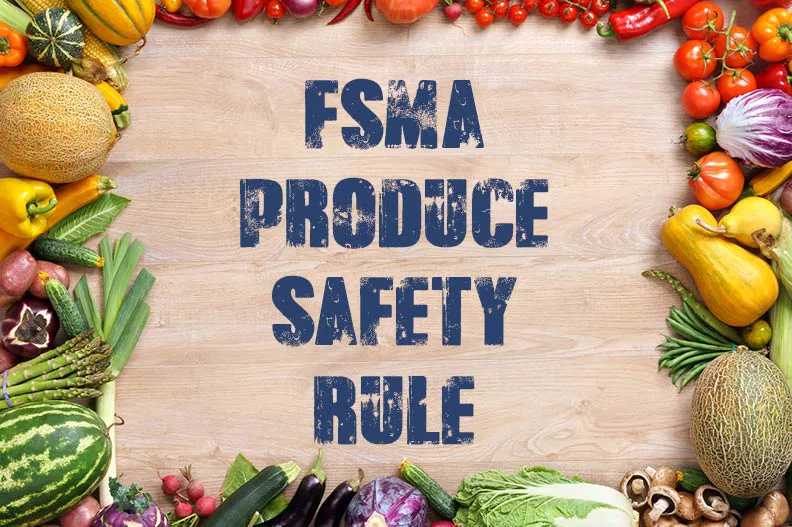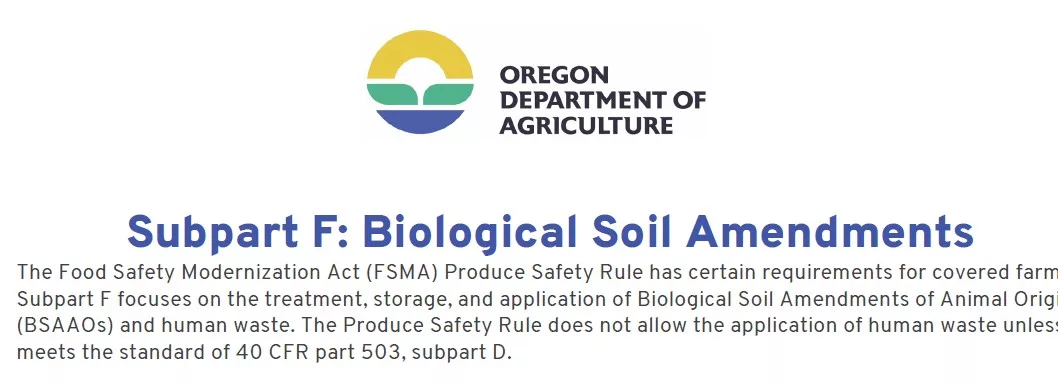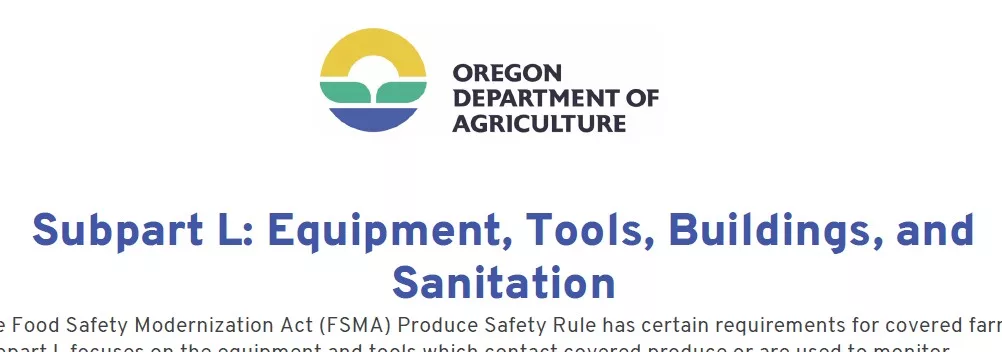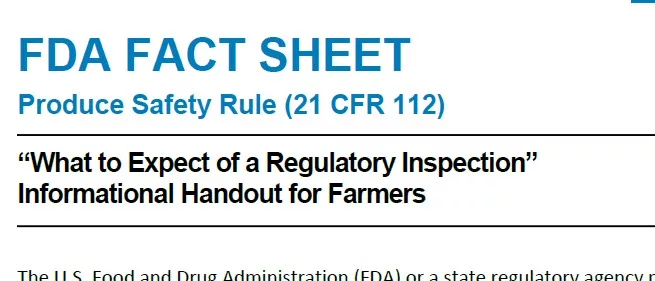
Produce Safety Rule
Food & Drug Administration
Food Safety Modernization Act Requirements
The Produce Safety Rule (PSR) is a set of federal regulations, part of the Food Safety Modernization Act (FSMA), that establishes minimum standards for the safe growing, harvesting, packing, and holding of fruits, vegetables, mushrooms, and sprouts intended for human consumption. Its primary goal is to prevent contamination and reduce foodborne illnesses associated with fresh produce.
Use the coverage and exemptions flowchart to determine if you are included in the produce safety rule
Agricultural water is water used on covered produce where water is intended to (or is likely to) contact covered produce or food contact surfaces. Pre-harvest agricultural water refers to water used during growing activities, such as for irrigation and crop protection sprays. Harvest and post-harvest agricultural water refers to water used in harvesting, packing, and holding activities, such as water used to prevent dehydration, for transport, cooling, and washing. This includes water used for handwashing during and after harvest activities.
In addition to the requirements already in place to conduct water quality testing and conduct an annual Agricultural Water System Inspection, farms are now required to also conduct an annual Agricultural Water Assessment to evaluate a variety of factors that could impact contamination risks associated with pre-harvest water:
- Water system (e.g., ground vs surface, open or closed to the environment)
- Water use practices (e.g., sprinkler or spray vs drip vs furrow)
- Crop characteristics (e.g., susceptibility of internalization)
- Environmental conditions (e.g., air temperatures, extreme weather events)
- Impacts from adjacent and nearby land (e.g., animal activity)
- Other relevant factors (e.g., testing results)
Based on their agricultural water assessments, covered farms must determine if corrective actions or mitigation measures are necessary.
Interactive Tool: Agricultural Water Assessment Builder
This interactive tool is designed to help farms understand the requirements for an agricultural water assessment in the “Standards for the Growing, Harvesting, Packing, and Holding of Produce for Human Consumption Relating to Agricultural Water” final rule.

Differences Between an Ag Water Inspection and Assessment
The Agricultural Water Inspection and the Agricultural Water Assessment are two separate requirements for the Produce Safety Rule. Find more information about each here.

Factors to Consider for an Ag Water Assessment
A chart that summarizes the factors farms are required to consider as part of the ag water assessment.
Treatment Requirements
Biological Soil Amendments of Animal Origin (BSAAOs) can be treated with thermal, chemical (high alkaline pH), or biological (composting) methods.
Common treatments include:
- Static composting that maintains oxygenated conditions at a minimum of 131° for 3 consecutive days followed by adequate curing.
- Turned composting that maintains oxygenated conditions at a minimum of 131° for 15 days with a minimum of five turnings and followed by adequate curing.
Storage Requirements
If a BSAAO is treated, it is important to store and handle it correctly so as not to contaminate it. The rules requires you must store and handle treated BSAAOs:
- In a location so it does not become a potential contamination source for covered produce, food contact surfaces, water sources and distribution systems, and other soil amendments.
- In a location that minimizes the risk of it becoming contaminated If it is suspected a BSAAO may have become contaminated during storage or handling, it must be handled as though it were untreated.
Untreated BSAAOs
BSAAOs may be considered untreated and need special handling if it:
- Has not been processed in accordance with requirements of the Rule.
- Has been contaminated after treatment.
- Has been combined with an untreated BSAAO.
- Contains a component that is contaminated.
- Is an agricultural tea which contains an additive.
- Is an agricultural tea made from untreated surface water or water which has detectable generic E. coli in 100 mL of water.
Sprouts
- Sprouts have been frequently associated with foodborne illness outbreaks; due to this, there are requirements specifically related to the growth of sprouts: taking measures to prevent the introduction of dangerous microbes into seeds or beans used for sprouting, testing of irrigation water for each batch, and testing the growing and holding environments for Listeria.

Subpart F: Biological Soil Amendments
Summary of requirements for biological soil amendments.
The Rule does not require covered farms to exclude animals from outdoor growing areas or destroy animal habitat. Rather, the Rule encourages growers to monitor for contamination from animal intrusion.
Animal Intrusion
If there is reasonable probability that animals, whether grazing, working or wild, will contaminate covered produce through intrusion, an operation must:
- Assess areas used for covered produce for contamination by visual examination.
- If contamination is found, assess whether the produce can be harvested.
- Take measures reasonably necessary during growing to assist you later during harvest when you must identify and not harvest covered produce that is reasonably likely contaminated with a known or reasonably foreseeable hazard.

Subpart I: Domesticated & Wild Animals
Summary of requirements for domesticated and wild animals.
All personnel must receive training upon hiring, as necessary, and at least once annually.
Training Requirements
At a minimum, all personnel who handle covered produce during covered activities or those in supervisory roles must receive training that includes:
- Principles of food hygiene and food safety.
- Recognizing the symptoms of health conditions that may result in the contamination of covered produce or food contact surfaces.
For those who are engaged in harvest of covered produce, training must also include:
- Recognizing produce that must not be harvested.
- Inspecting harvest containers and equipment to ensure they are in acceptable condition.
- Correcting problems with harvest containers or equipment, or reporting such problems to a supervisor.
- In addition, each farm must have at least one supervisor or responsible party complete Produce Safety Alliance (PSA) Grower Training.

Unwell Persons
Operations covered by the Produce Safety Rule must take measures to prevent contamination of covered produce or food contact surfaces from those who are ill or infected. Those with applicable conditions must be excluded from working in positions which could contaminate produce or food contact surfaces.
Symptoms may include:
- Vomiting
- Diarrhea
- Open lesion
- Infection
Personnel Requirements
At a minimum, all personnel who handle covered produce during covered activities must use the following hygienic practices:
- Maintain adequate personal cleanliness.
- Avoid contact with animals. When working with working animals, minimize contamination of covered produce.
- Proper handwashing.
- If using gloves, keeping them in an intact and sanitary condition.
- Remove or cover any jewelry which cannot be cleaned or sanitized.
- No eating, chewing gum or tobacco use in areas used for covered activities.
- Notify a supervisor or responsible party if they have an applicable health condition.
Visitors
Health and hygiene requirements also apply to visitors on your operation. A visitor is any person who enters your covered farm with your permission. Visitors must:
- Be aware of and comply with your farm’s policies and procedures regarding health and hygiene.
- Have access to toilet and handwashing facilities.

Buildings
- Must be suitable in size, construction, and design to promote maintenance and sanitary conditions.
- Allot sufficient space for placement of equipment and storage of materials.
- Take proper precautions to reduce the potential for contamination of covered produce, food contact surfaces or packing materials. This could be through location, time, partition, enclosure or other means.
- Provide adequate drainage where normal operations have liquid waste.
- Prevent contamination of covered produce or food contact surfaces from floors, walls, ceilings, fixtures, ducts, pipes, drips or condensate.
Tools & Equipment
- You must use equipment and tools that are able to be cleaned and properly maintained.
- Installed and maintained so they are able to be cleaned.
- Stored and maintained in a way to prevent contamination of covered produce,
- Seams on food contact surfaces must not accumulate contamination.
- You must inspect, maintain, clean, and when necessary, sanitize food contact surfaces and tools.
- Maintain and clean non-food-contact surfaces of equipment and tools as necessary to protect against contamination of covered produce.
- If using equipment to transport covered produce, you must minimize the potential for contamination.
- Equipment used for transporting covered produce must be adequate for use and adequately clean prior to moving covered produce.
Instruments & Controls
- Any instruments or controls used to measure, regulate, record temperatures, pH, sanitizer concentrations or other conditions to control or prevent the growth of pathogens of concern must meet these requirements:
- Accurate and precise in keeping with their purpose.
- Adequately maintained.
- Adequate in number for their designed use.
Toilet Facilities
The Rule requires you must provide personnel with adequate, readily accessible toilet facilities. These toilet facilities must:
- Prevent contamination of covered produce, food contact surfaces, and water sources distribution systems.
- Be directly accessible for servicing.
- Be serviced and cleaned at adequate intervals.
- Kept supplied with toilet paper.
- Provide for the sanitary disposal of waste and toilet paper.
- Provide disposal of water from handwashing.
- If a toilet is in a fully-enclosed building, handwashing facilities must be nearby toilet facilities for easy handwashing.
Waste Disposal
The Rule requires you must transport, store, and dispose of trash, litter, and waste to prevent contamination. By doing so, you must:
- Minimize the potential for attracting and harboring pests.
- Prevent contamination of covered produce, food contact surfaces, areas used for a covered activity, and agricultural water sources and distribution systems.
- Operate systems for waste treatment and disposal so that they are not a threat of contamination.
Plumbing
The Rule requires plumbing must be of adequate size, design, installation, and maintenance to:
- Distribute water under pressure as necessary.
- Properly transport sewage and liquid disposable waste.
- Avoid being a source of contamination for covered produce, food contact surfaces, areas used for a covered activity, and agricultural water sources and distribution systems.
- Not allow backflow from or a cross-connection between piping systems that discharge wastewater or sewage and piping systems that carry water used for a covered activity, sanitary operations, or use in handwashing facilities.
Sewage Disposal
The Rule requires you must:
- Dispose of sewage into an adequate sewage or septic system.
- Maintain sewage and septic systems in a manner that prevents contamination of covered produce, food contact surfaces, areas used for a covered activity, and agricultural water sources and distribution systems.
- Manage and dispose of leaks or spills to prevent contamination of covered produce, food contact surfaces, areas used for a covered activity, and agricultural water sources and distribution systems.
- Take appropriate steps to ensure that sewage and septic systems operate in a manner that will not contaminate covered produce, food contact surfaces, areas used for a covered activity, and agricultural water sources and distribution systems after a natural disaster.
- This section of the rule covers greenhouses, germination chambers, and other structures, as well as toilet and hand-washing facilities.
Handwashing Facilities
The Rule requires you must provide personnel with adequate, readily accessible hand-washing facilities during growing, harvest, packing and holding. These hand wash facilities must have:
- Soap
- Running water
- Single use towels or electric hand dryers
- Appropriate disposal of waste such as used paper towels.
** Antiseptic hand rubs, like hand sanitizer, cannot be used as a replacement for proper handwashing.
Pest Control
The Rule requires that you must:
- Take measures reasonably necessary to protect covered produce, food contact surfaces, and food-packing materials from contamination by pests, including routine monitoring.
- If the building is fully-enclosed, you must exclude pests.
- If the building is partially enclosed, you must take measures to prevent pests from becoming established in the building.
Records
You must keep records documenting the cleaning and sanitizing of equipment used for covered harvesting, packing, and holding activities. These records must contain:
- Name and location of farm.
- Actual values and observations during monitoring.
- Description of covered produce affected by record.
- Location of area applicable to record.
- Date and time of activity documented.

Subpart L: Equipment, Tools, Buildings & Sanitation
Summary of requirements for equipment, tools, buildings, and sanitation.
On-Farm Readiness Reviews (OFRRs) are a free and confidential way to help operations prepare for inspections. OFRRs allow operations to assess how well they align with the Produce Safety Rule. These reviews are conducted by the Oregon Department of Agriculture, and they are most helpful when conducted as close to harvest as possible.
During the OFRR, you can discuss the specifics of your operation with the review team to assess which parts of the Produce Safety Rule applies to your operation and where you need assistance meeting the requirements. Plan on 2-3 hours to talk about and walk around your operation to examine the aspects of the Produce Safety Rule that you should be in compliance with.

What to Expect of a Regulatory Inspection
This informational handout details what to expect of a Produce Safety Rule regulatory inspection.
At least one employee from each farm is required to attend a Produce Safety Alliance training.
Find in-person, remote, and on-demand online trainings here.
